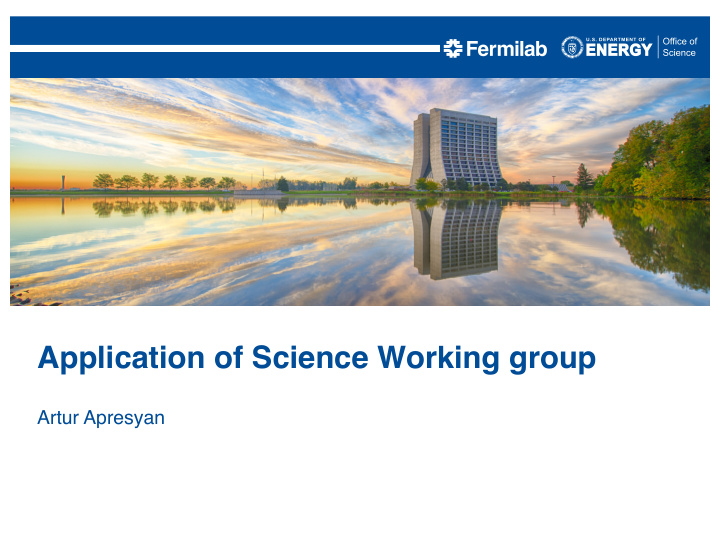



Application of Science Working group Artur Apresyan
Introduction • My current activities are focused on – CMS experiment at the LHC • Data analysis (searches for new physics, SUSY) and High- Luminosity LHC upgrades – Generic R&D into precision timing detectors for future experiments (sub-100 psec precision) • Micro-channel plates, SiPM, Ultra-Fast silicon sensors • I will focus on areas that I have worked on and highlight a few possible applications of these 2 4/19/17 A. Apresyan | Applications of Science Pre-retreat
Timing • For the CMS and other future hadron colliders: – High instantaneous luminosity is a key to get to our goals of finding new physics at low production cross-sections – Cost: large amount of pileup of overlapping collisions • Solution in CMS: – Precise charged particle trackers (mature technology), – Precise time tagging of each particle in the event at the level of 20 psec • Several technologies now 3 4/19/17 A. Apresyan | Applications of Science Pre-retreat
Timing • Several detector technologies have been shown by now to achieve or approach the needed level – Micro-Channel-Plate detectors – APDs with various designs for the gain layer – SiPMs • CMS is pursuing SiPM and APD options for Phase 2 upgrades • FNAL has years of expertise in these technologies – SiPM: CMS HCAL, CMS BTL, CMS HGCal – MCP: crucial work in the LAPPD development, many core team members from FNAL, labs to fabricate components – APD: NOvA, CMS ETL 4 4/19/17 A. Apresyan | Applications of Science Pre-retreat
Timing • Commercialization of timing detectors (LAPPD): – Over the years the LAPPD consortium has identified several areas that a large area, cheap PMT would be needed – Examples are: night vision, border protection, security scanners, PET-TOF, medical imaging,… • Border protection: – Having LAPPD size cheap sensors could allow one to build a large area scanner for border control (e.g. scan a large truck, with higher rate and accuracy) 5 4/19/17 A. Apresyan | Applications of Science Pre-retreat
Timing • FNAL has worked in the past with PET-TOF SiPM applications, but the project didn ’ t finish (afaik) – Large improvement expected in PET-TOF if time resolution below 100 psec can be achieved: – Will dramatically reduce the exposure of the patients at the same precision • Extensive knowledge in large experiments – We are now starting a large program of SiPM and UFSD based detector for CMS Phase 2, so the capabilities are growing – Several labs in SiDet equipped to do precision timing R&D, and expanding (LDRD awarded this year). – We are developing the ASIC, and multi-channel synchronization for the CMS project: critical for any large scale application 6 4/19/17 A. Apresyan | Applications of Science Pre-retreat
Timing • LIDAR technology in autonomous vehicles (drones, cars, etc): – An area that is expected to grow very fast, soon (Google, Uber..) – Laser light collected by the sensor on board: • convert the time-of -flight into an analog signal, process on board with the ASIC • An area where we have a lot of natural expertise in sensor development (SiDet) and signal processing (ASIC) – A fruitful collaboration with industry could involve common projects on both of these – A project in Uni of Geneva, in collaboration with medical industry on developing a SiGe ASIC for TOF-PET with best power consumption 7 4/19/17 A. Apresyan | Applications of Science Pre-retreat
Big Data Analysis • A large effort in CERN to bring ourselves up to speed with the industry on Machine Learning – Several forums organized within CERN, and within CMS – Collaborative meetings with industry, joint projects with Nvidia on GPU processing etc. • Common projects in CMS involve things like track reconstruction with deep learning NN, using GPUs – Interesting project for both industry and for us in the HL-LHC environment of extreme PU – Collaborations with Simons foundation, strong expertise in the SCD, Data Science in HEP workshop soon at Fermilab 8 4/19/17 A. Apresyan | Applications of Science Pre-retreat
Conclusion • Common issue in many of these possible applications – Not enough time/funding to pursue both the work on the project and the “generic” R&D for the technology transfer • Need to find partners that share the same intermediate goal to which we can collaborate on – Our goals after this step can be different, but we both benefit from collaboration to get to that step • Not clear to me if the facilities available in FNAL are widely known to the R&D communities in the industry? – Do we have a strong enough presence at trade shows, specialized conferences, IEEE meetings? 9 4/19/17 A. Apresyan | Applications of Science Pre-retreat
Recommend
More recommend